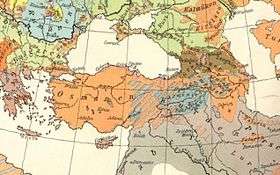Ethnic groups in the Middle East
The ethnic groups in the Middle East refers to the peoples that reside in Western Asia and Egypt in North Africa, a transcontinental region commonly known as the Middle East. The region has historically been a crossroad of different cultures. Since the 1960s, the changes in political and economic factors (especially the enormous oil wealth in the region and conflicts) have significantly altered the ethnic composition of groups in the region. While some ethnic groups have been present in the region for millennia, others have arrived fairly recently through immigration. The largest ethnic groups in the region are the Arabs, Azerbaijanis, Egyptians,[1][2][3] Kurds, Persians, and Turks,[4] but there are dozens of other ethnic groups which have hundreds of thousands, if not millions, of members.
Other indigenous, native, or long-standing ethnic or ethnoreligious groups include: Arameans, Armenians, Assyrians, Baloch, Berbers, Copts, Druze, Gilaks, Greeks, Jews, Kawliya, Lurs, Mandaeans, Maronites, Mazanderanis, Mhallami, Nawar, Samaritans, Shabaks, Talysh, Tats, Turkmens, Yazidis and Zazas.
More recent migrant or diaspora populations include Albanians, Bengalis, Britons, Bosniaks, Chinese, Circassians, Crimean Tatars, Filipinos, French people, Indians, Indonesians, Italians, Malays, Pakistanis, Pashtuns, Punjabis, Romani, Sikhs, Sindhis, Somalis, Sri Lankans, and Sub-Saharan Africans.
Demographics
Middle East
- Alawites
- Bahranis
- Bidoon
- Bedouins
- Druze
- Egyptians (excluding ethnolinguistic and ethnoreligious groups like the Copts and Nubians, who openly reject an Arab identity)
- Emiratis
- Hadhrami
- Iraqis (including the Marsh Arabs but excluding ethnic minorities like the Armenians, Assyrians, Circassians, Kawliya, Kurds, Mandaeans, Shabaks, Turkmen, and Yazidis)
- Jordanians (excluding ethnic minorities like the Armenians, Circassians, and Kurds)
- Kuwaitis
- Lebanese (excluding some Christians, especially Maronites, who instead claim a Phoenician identity, and ethnic minorities like the Armenians, Assyrians, and Kurds)
- Mehri
- Omanis
- Palestinians
- Qataris
- Saudis
- Solluba
- Syrians (excluding ethnic minorities like the Arameans, Armenians, Assyrians, Circassians, Kurds, Nawar–Roma, Turkmen, and Yazidis)
- Yemenis
- Africans – Sub-Saharan Africans
- Arameans
- Arameans in Israel
- Arameans in Syria
- Assyrians
- Mandaeans
- Mhallami
Anatolia

- Kartvelian peoples
Diaspora populations
Because of the low population of many of the Arab States of the Persian Gulf and the demand for labor created by the large discoveries of oil in these countries there has been a steady stream of immigration to the region (mainly from South Asia). Ethnic groups which comprise the largest portions of this immigration include Afghans, Bengalis, Britons, Chinese, Filipinos, Indians, Indonesians, Malays, Nepalis, Pakistanis, Punjabis, Sikhs, Sindhis, Somalis, Sri Lankans, and Sub-Saharan Africans. Many of these people are denied certain political and legal rights in the countries in which they live and frequently face mistreatment by the native-born citizens of the host countries.
See also
References
- "Egypt".
By far the largest ethnic group in Egypt are the Egyptians, which refers to both an ethnic group and a nationality
- "National Geographic DNA analysis project proves that Egyptians and Tunisians are not Arabs".
68 percent of the indigenous population is from North Africa, four percent are from Jewish ancestry...
- "Egyptians are 71% North Eastern African nation".
- Ethnic Groups of Africa and the Middle East: An Encyclopedia. Retrieved 26 May 2014.